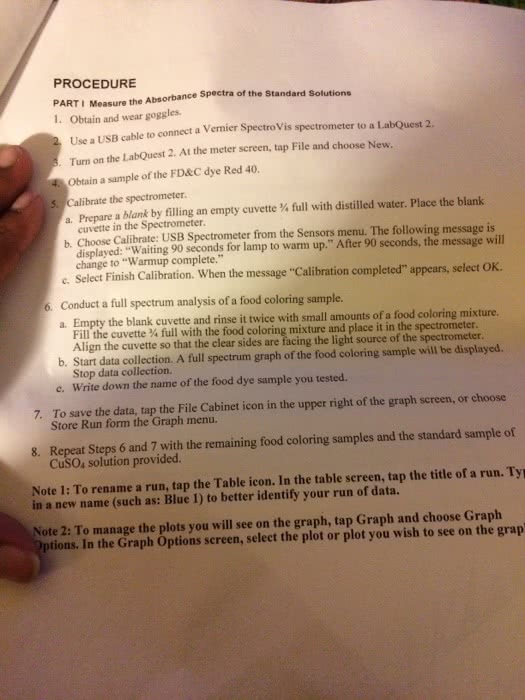Procedure for Part 1 1.Using the TV Specs, observe and record atomic emission spectra from H lamp. 2.Sketch the atomic emission spectrum of H. Include color and wavelength.3.Repeat step 1 with the Hg lamp.4.Sketch the atomic emission spectrum of Hg. Include color and wavelength.5.Repeat step 1 with the Helamp.6.Sketch the atomic emission spectrum of He. Include color and wavelength.
Procedure for Part 2
4.Conduct a full spectrum analysis of a colored solution.a.Fill a cuvette ¾ full with the colored solution and place it in the spectrometer. Align the cuvette so that the clear sides are facing the light source of the spectrometer.b.Click . A full spectrum graph of the colored solution will be displayed.c.Once signal has stabilized, click d.Examine the graph, noting the peak or peaks of very high absorbance or other distinguishing features. Compare the color of the solution with the wavelength associated with that color. Use the ârainbowâ chart drawn above.e.To Save your graph, select Store Latest Run from the Experiment menu.
Post lab question
1. Briefly explain why the gas discharge tube glows when the high voltage is
applied. Why does the gas not glow when the voltage is turned off.
2. When you look directly at the gas discharge tube through the grating, do you see the color
of a single wavelength of light or a blend of wavelengths?
3.Other than our blending of colors of different wavelengths emitted from a single source,
what is another limitation of using our eyes to detect electromagnetic radiation?
4. Explain how the emission phenomenon can be used
to find out what elements are present in an unknown sample.
5. What is a continuous spectra? What type of source creates a continuous spectra?
6. Explain why atomic emission spectra are not continuous.
7. How many lines are there in the Hg line spectra? How many
did you see? What might be the reason that these two answers are different?
8. Why do atoms absorb and emit light of the same frequency? In other words, why donât
atoms absorb light at one set of frequencies and emit light at another set of frequencies?
9. Why does the atomic emission spectrum vary from element to element? Explain how
atomic structure influences the spectrum.
10. In part 2, does the wavelength of maximum absorbance (ie: the color that corresponds to
the wavelength) for each solution correspond to the color of the solution that you âseeâ?
Describe why or why not? (For instance, for the red solution, was the highest absorbance
measured at the red wavelength and describe why or why not?)
plz help me answer as much as possible thanks
Procedure for Part 1 1.Using the TV Specs, observe and record atomic emission spectra from H lamp. 2.Sketch the atomic emission spectrum of H. Include color and wavelength.3.Repeat step 1 with the Hg lamp.4.Sketch the atomic emission spectrum of Hg. Include color and wavelength.5.Repeat step 1 with the Helamp.6.Sketch the atomic emission spectrum of He. Include color and wavelength.
Procedure for Part 2
4.Conduct a full spectrum analysis of a colored solution.a.Fill a cuvette ¾ full with the colored solution and place it in the spectrometer. Align the cuvette so that the clear sides are facing the light source of the spectrometer.b.Click . A full spectrum graph of the colored solution will be displayed.c.Once signal has stabilized, click d.Examine the graph, noting the peak or peaks of very high absorbance or other distinguishing features. Compare the color of the solution with the wavelength associated with that color. Use the ârainbowâ chart drawn above.e.To Save your graph, select Store Latest Run from the Experiment menu.
Post lab question
1. Briefly explain why the gas discharge tube glows when the high voltage is
applied. Why does the gas not glow when the voltage is turned off.
2. When you look directly at the gas discharge tube through the grating, do you see the color
of a single wavelength of light or a blend of wavelengths?
3.Other than our blending of colors of different wavelengths emitted from a single source,
what is another limitation of using our eyes to detect electromagnetic radiation?
4. Explain how the emission phenomenon can be used
to find out what elements are present in an unknown sample.
5. What is a continuous spectra? What type of source creates a continuous spectra?
6. Explain why atomic emission spectra are not continuous.
7. How many lines are there in the Hg line spectra? How many
did you see? What might be the reason that these two answers are different?
8. Why do atoms absorb and emit light of the same frequency? In other words, why donât
atoms absorb light at one set of frequencies and emit light at another set of frequencies?
9. Why does the atomic emission spectrum vary from element to element? Explain how
atomic structure influences the spectrum.
10. In part 2, does the wavelength of maximum absorbance (ie: the color that corresponds to
the wavelength) for each solution correspond to the color of the solution that you âseeâ?
Describe why or why not? (For instance, for the red solution, was the highest absorbance
measured at the red wavelength and describe why or why not?)
plz help me answer as much as possible thanks

